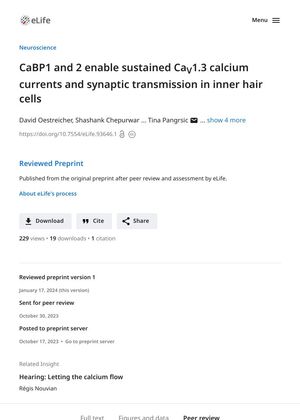CaBP1 and 2 Enable Sustained CaV1.3 Calcium Currents and Synaptic Transmission in Inner Hair Cells
January 2024

TLDR CaBP1 and 2 are necessary for maintaining calcium currents and hearing in inner ear cells.
The study investigates the role of calcium-binding proteins (CaBPs) 1 and 2 in the inactivation of the Cav1.3 calcium channels in cochlear inner hair cells (IHCs). The authors used knockout mice of CaBP1 and CaBP2 to show that these proteins are necessary for enabling sustained calcium currents by reducing calcium-dependent inactivation (CDI) and enabling proper IHC neurotransmitter release. The study also found that reintroducing CaBP2 using an injection of AAV containing the CaBP2 sequence into the cochlea restored some of the auditory function and reduced CDI. However, the study did not clarify how CaBP1 and CaBP2 work together or the effect of reintroducing both proteins. The study's findings could help explain the phenotype of the human autosomal recessive DFNB93, which is based on the malfunction of CaBP2. Future research should explore the molecular mechanisms of the interaction of CaBP1 and 2 in regulating Cav1.3 inactivation.




